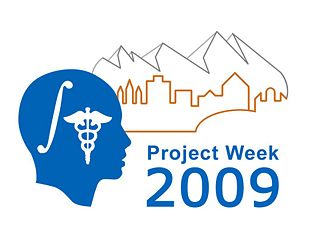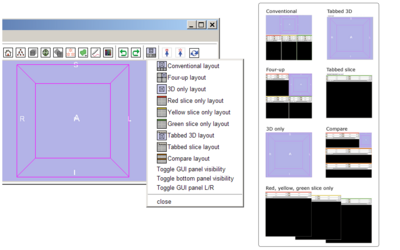Difference between revisions of "2009 Winter Project Week SlicerLayouts"
From NAMIC Wiki
(New page: {| |thumb|320px|Return to [[2009_Winter_Project_Week|Project Week Main Page ]] |[[Image:scarmri_namic.jpg|thumb|320px|Image showing scar in the left atrium using MR...) |
m (Text replacement - "http://www.slicer.org/slicerWiki/index.php/" to "https://www.slicer.org/wiki/") |
||
| (9 intermediate revisions by one other user not shown) | |||
| Line 1: | Line 1: | ||
{| | {| | ||
|[[Image:NAMIC-SLC.jpg|thumb|320px|Return to [[2009_Winter_Project_Week|Project Week Main Page]] ]] | |[[Image:NAMIC-SLC.jpg|thumb|320px|Return to [[2009_Winter_Project_Week|Project Week Main Page]] ]] | ||
| − | |[[Image: | + | |[[Image:AppLayouts.png|thumb|400px|Current layouts in Slicer]] |
| − | |||
|} | |} | ||
| Line 10: | Line 9: | ||
===Key Investigators=== | ===Key Investigators=== | ||
| − | * | + | * GE: Jim Miller |
| − | * | + | * BWH: Wendy Plesniak |
| − | * | + | * Isomics: Steve Pieper |
| − | |||
<div style="margin: 20px;"> | <div style="margin: 20px;"> | ||
| Line 20: | Line 18: | ||
<h1>Objective</h1> | <h1>Objective</h1> | ||
| − | + | Currently Slicer has the ability to display a fixed set of layouts (often called 'hanging protocols' on Radiology Workstations). Most commercial packages offer a richer set of default layouts that are appropriate for certain modalities and studies, and an ability to configure and save custom layouts. This project will adapt Slicer's existing software to offer default layouts familiar to radiologists, and will develop new software and GUI to let users create and save custom layouts as well. | |
| − | |||
| − | |||
</div> | </div> | ||
| Line 28: | Line 24: | ||
<h1>Approach, Plan</h1> | <h1>Approach, Plan</h1> | ||
| − | + | * Review the current implementation in Slicer, | |
| − | + | * design a new layout module in Slicer's Base, and its interface. | |
| − | + | * Study default layouts commonly provided by commercial software and | |
| − | + | * create them as selectable options. | |
| + | * provide ability to show/hide/configure attributes of Slice Viewers & their controls within each layout. | ||
</div> | </div> | ||
| Line 37: | Line 34: | ||
<h1>Progress</h1> | <h1>Progress</h1> | ||
| − | + | * Much cleaning up and generalizing of original layout code | |
| − | + | * Creation of a SlicesModule with interfaces to control each SliceViewer. | |
| − | + | * Reviewed default hanging protocols and customizing options on various commercial offerings at RSNA. | |
| + | * Discussed various options for [https://www.slicer.org/wiki/Slicer3:UIDesign:WorkingProblems:SlicerFlexibleLayout:Architecture representing layouts] and considered them against interaction design | ||
| + | * Decided on approach using compact tree-based representation for layout and [https://www.slicer.org/wiki/Slicer3:UIDesign:WorkingProblems:SlicerFlexibleLayout:UXP simple cell-based modification] of layouts. | ||
</div> | </div> | ||
| Line 47: | Line 46: | ||
===References=== | ===References=== | ||
| − | |||
| − | |||
| − | |||
Latest revision as of 18:07, 10 July 2017
Home < 2009 Winter Project Week SlicerLayouts Return to Project Week Main Page |
Key Investigators
- GE: Jim Miller
- BWH: Wendy Plesniak
- Isomics: Steve Pieper
Objective
Currently Slicer has the ability to display a fixed set of layouts (often called 'hanging protocols' on Radiology Workstations). Most commercial packages offer a richer set of default layouts that are appropriate for certain modalities and studies, and an ability to configure and save custom layouts. This project will adapt Slicer's existing software to offer default layouts familiar to radiologists, and will develop new software and GUI to let users create and save custom layouts as well.
Approach, Plan
- Review the current implementation in Slicer,
- design a new layout module in Slicer's Base, and its interface.
- Study default layouts commonly provided by commercial software and
- create them as selectable options.
- provide ability to show/hide/configure attributes of Slice Viewers & their controls within each layout.
Progress
- Much cleaning up and generalizing of original layout code
- Creation of a SlicesModule with interfaces to control each SliceViewer.
- Reviewed default hanging protocols and customizing options on various commercial offerings at RSNA.
- Discussed various options for representing layouts and considered them against interaction design
- Decided on approach using compact tree-based representation for layout and simple cell-based modification of layouts.
